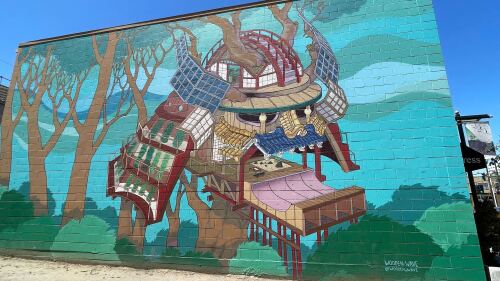You can’t look at the history of San Jose without looking into History San José (HSJ), the local organization that strives to highlight our region’s diverse cultural history through engaging experiences, exhibits, festivals, educational programs, and research. Let’s go inside the group’s 75+ years of history and its ever-expanding work today.
At a glance
Today, History San José is a huge organization that operates in three main areas:
- History Park — which includes 32 original and reconstructed buildings + 19 affiliate museums across 14 acres of Kelley Park
- Downtown’s Gonzalez/Peralta Adobe + the Carmel & Thomas Fallon House
- The extensive archives in the Collection Center
Using these distinct branches, HSJ manages one of the largest collections of regional history in California.
So how did this all come to be?
Humble beginnings
History San José would not exist without one man — Clyde Arbuckle. Born in 1903, his family was among the early pioneer-settlers who came to the Santa Clara Valley in 1846. These deep roots inspired a deep love for history.
Despite a lack of formal education, Arbuckle became so known for his historic retellings, that he was selected as San Jose’s honorary City Historian in 1945. In this role, he received countless historic letters, diaries, records, and objects from the public. The collection grew, but there was no place to house them — until 1949.
To mark the centennial of California’s statehood, a replica of the original State House was built in San Jose’s City Hall Plaza. The replica was such a hit with residents, the city purchased and moved it to the Santa Clara Fairgrounds where it became San Jose’s first museum — with Clyde serving as its director and curator. The State House Museum still stands in the Fairgrounds to this day, but no longer operates as a museum.
“A museum of museums”
By 1971, the city expanded the “San José Historical Museum” to Kelley Park to mirror some of the popular historic towns on the East Coast like Colonial Williamsburg or Plymouth Plantation.
Initially imagined as a “Victorian Village,” History Park eventually expanded to include original + reconstructed buildings from outside that period, highlighting the lesser-heard stories from San Jose’s diverse communities.
Thus, the affiliate program allowed HSJ to become “a museum of museums,” as it now hosts the Chinese American Museum, the Portuguese Historical Museum, the African American Heritage House, and the Museum of the Boat People and Republic of Vietnam — to name a few.
The future
History San José celebrated its 75th anniversary in 2024. To honor the milestone, the organization unveiled a three-year, rotating exhibit titled “Valley Memories: Curiosities & Treasures from History San José’s Collection,” which features never-before-seen artifacts including motorcycles, sports jerseys, radios and cameras.
“History doesn’t end,” President Bill Schroh, Jr. notes. “We’re always working to save, preserve, and add new voices.” As such, a few years ago, History San José was working with the local Tamien + Ohlone Nations to develop a First Peoples Heritage Center at History Park, and was in negotiations with the Union Pacific Railroad to save a train depot from 1869 — the oldest one that’s still around.
In 2025, History San José is working with JAMsj to move North San Jose’s Sakauye Farmhouse to History Park with the help of donations.
Getting involved
History San José relies on 20,000 volunteer hours per year to run. The organization regularly needs community members to help in these roles:
- Tour guides
- History Park hosts + docents
- Gardeners
- Assistants for special events + public programs
- Trolley drivers
- Maintenance experts
If you can’t volunteer your time, consider membership and donations.















